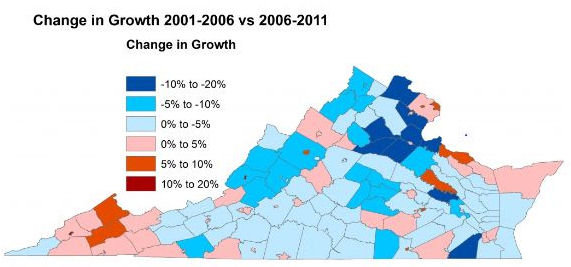As a follow-up to the previous blog post, let me bring to readers’ attention the work of Hamilton Lombard, Demographics & Workforce research specialist for the Weldon Cooper Center. In a May blog post, his analysis of census data in Virginia led to this conclusion: “The recession significantly altered the growth patterns in Virginia, smoothing out growth rates across much of the state, and accelerating urban population growth in the last five years.”
Comparing the five-year periods of 2001-2006 to 2006-2011, Hamilton found that population growth in the fast-growing counties on the outer fringe of the Washington and Richmond metropolitan regions (colloquially known as the exurbs) decelerated rapidly. Populations in those counties still grew, just not nearly as fast.
Meanwhile, jurisdictions that had seen slow growth or outright declines experienced a pick-up. The map above highlights the changes. Blue jurisdictions saw the greatest decline in the rate of growth (not an absolute decline in growth), while the beige/orange shows a pick-up in, or resumption of, growth.
Hamilton’s blog post ranks the top 10 decelerators, topped by Loudoun County, which slowed from a 41.2% growth rate to a 20.1% growth rate. The biggest turn-around story was the City of Norton in the heart of the Virginia coalfields, reversing from a 6.3% decline to 12.7% growth.
Bacon’s bottom line: This is one more body of evidence that the pattern of growth and development in Virginia experienced a major inflection point during the 2007-2008 recession. This does not mean suburban growth is dead. It does mean that such growth has spent much of its energy and the the fortunes of traditional inner cities and small towns are reviving.
— JAB



